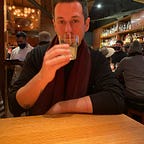Four Ways To Make Better Cocktails At Home
Be your own Bartender
5 min readDec 2, 2020
The Coronavirus pandemic of 2020 has forced craft cocktail lovers to abandon their nightly reverie in bars. With Covid-19 cases on the rise, in thousands of cities in America, it’s unsafe — if not impossible — to go out for a cocktail.
Our battle with the virus doesn’t mean we can’t enjoy great drinks in this last season of the…
